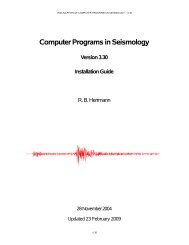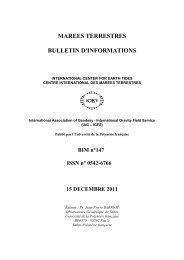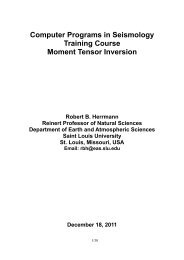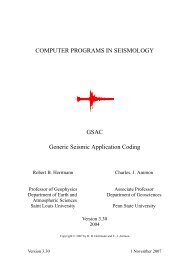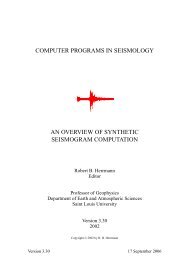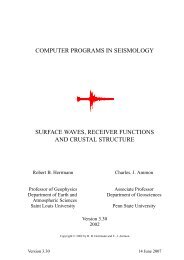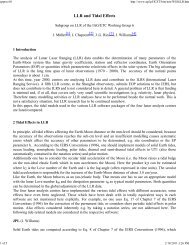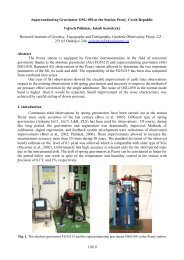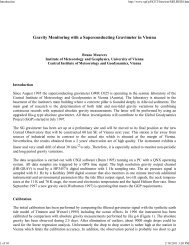3.04 Gravimetric Methods – Superconducting Gravity Meters
3.04 Gravimetric Methods – Superconducting Gravity Meters
3.04 Gravimetric Methods – Superconducting Gravity Meters
You also want an ePaper? Increase the reach of your titles
YUMPU automatically turns print PDFs into web optimized ePapers that Google loves.
72 <strong>Superconducting</strong> <strong>Gravity</strong> <strong>Meters</strong><br />
weaker. This effect was first observed in 1981 when the<br />
TT30 was installed in the cellar vault in the ROB. In<br />
contrast, trains did not affect operation of the LCR<br />
gravity meter operating in a nearby vault.<br />
The SG is supplied with an automatic leveling<br />
system consisting of two tiltmeters mounted orthogonally<br />
on top of the gravimeter vacuum can and two<br />
thermally activated levelers that are placed under<br />
two of the dewar support points. After tilt-minimizing<br />
the SG sensor, the tiltmeters are ‘aligned’ to the<br />
same null by electronically setting their output voltages<br />
to zero. In feedback, the tiltmeters continuously<br />
adjust the power controlling the expansion of the<br />
levelers to keep alignment better than 1 mrad. This<br />
leveling precision is essential in gravity studies where<br />
apparent tilt-induced gravity changes must be kept<br />
less than 1 nGal (1 nGal ¼ 0.01 nm s 2 ). The tilt<br />
minimum adjustment is made on initial installation<br />
and checked every year or so by the operator. A<br />
recent study (Iwano and Fukuda, 2004) on SG data<br />
from the Syowa station shows the clear advantage of<br />
the tilt compensation system in reducing the noise in<br />
gravity, especially in the tidal range.<br />
<strong>3.04</strong>.1.2.5 Sphere and sphere resonance<br />
The sphere is a hollow superconducting shell that is<br />
manufactured with a slight mass asymmetry so that it<br />
has a preferred orientation when levitated. Various<br />
manufacturing processes are discussed in Warburton<br />
and Brinton (1995). A small hole is drilled on the top<br />
of the sphere to allow the helium gas to enter and to<br />
prevent a differential pressure from developing when<br />
it is cooled to 4 K. Just as important, the volume of<br />
the shell displaces 15 times less helium gas than the<br />
volume of the sphere; so the hole reduces buoyancy<br />
forces that result from changes in the surrounding<br />
helium gas pressure.<br />
When the gravimeter is tilted, particularly impulsively,<br />
the horizontal displacement of the sphere<br />
turns into an orbital motion (precession) with an<br />
associated vertical component in the feedback output.<br />
This mode appears as a sphere ‘resonance’ that<br />
has a period of 60<strong>–</strong>120 s depending on the particular<br />
instrument. In the absence of trapped magnetic fields<br />
and helium gas in the chamber, the Q of this mode is<br />
several thousand, so it is always excited making the<br />
instrument not usable. Slow damping of the mode is<br />
provided by adding helium gas to the chamber, but<br />
the resonance remains underdamped and is clearly<br />
visible in some of the instruments’ data. By comparison,<br />
the vertical resonance of the sphere is heavily<br />
damped with a period close to 1 s. Further technical<br />
details on the instrument design can be found in<br />
Goodkind (1991, 1999).<br />
<strong>3.04</strong>.1.3 Development of the Dual-Sphere<br />
Design<br />
In the early commercial SGs manufactured up to<br />
1990, offsets (or ‘tares’) occurred in the SG gravity<br />
records that affected both long-term stability and<br />
measurement of tidal factors (Seama et al., 1993;<br />
Harnisch and Harnisch, 1995; Hinderer et al., 1994).<br />
The offsets could be quite large (up to 100 mGal) if<br />
caused by mechanical shock from transferring liquid<br />
helium, power failures, or earthquakes. Small instrumental<br />
offsets less than 5 mGal could occur at random<br />
intervals that were not associated with outside disturbances.<br />
Rapid offsets larger than 0.2 mGal and<br />
occurring in less than 1 min could be easily detected<br />
and corrected (Merriam et al., 2001). However, there<br />
was a concern that the residual data would depend<br />
arbitrarily on the threshold value chosen in automatic<br />
offset detection programs (Harnisch and<br />
Harnisch, 1997). When two SGs were operated side<br />
by side, the difference in recordings provided a much<br />
clearer determination of the occurrence of offsets<br />
(Klopping et al., 1995).<br />
On the basis that random offsets will seldom occur<br />
in two sensors simultaneously, a dual-sphere SG was<br />
manufactured to solve the instrument offset problem<br />
(Richter and Warburton, 1998). The two spheres are<br />
mounted one above the other and separated by about<br />
20 cm. The lower sensor is manufactured exactly like<br />
previous single-sphere sensors, and the temperature<br />
and tilt control remain the same. Small differences in<br />
the sphere masses, superconducting shield, coil windings,<br />
and machining tolerances produce magnetic<br />
asymmetries that are not identical in the two sensors.<br />
These asymmetries produce slightly different tilt<br />
minima and require more complicated electronics<br />
to align the tilt minimum of the upper sensor with<br />
the lower sensor.<br />
The complications of a dual-sphere system are<br />
justified by providing a built-in instrumental offset<br />
detector. Because the outputs are treated as signals<br />
from two different gravimeters, the user can combine<br />
the processed data sets, select the least disturbed<br />
sphere output for any one time period, or convert<br />
the two signals into a gravity gradient by using the<br />
known vertical separation. CD029 was the first dualsphere<br />
SG produced and it was tested at Bad<br />
Homburg beginning July 1998 before being moved




